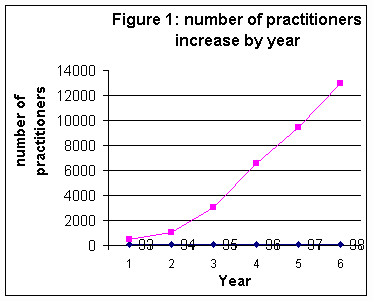
Survey1 Download
Falun Gong Health Effect Survey of Ten-thousand Cases in Beijing
Summary: To determine the health effect of Falun Gong, we conducted a survey among some Falun Gong practitioner in five districts in Beijing, with 12,731 valid questionnaires. Our results show that Falun Gong’s disease healing rate is 99.1% with a cure rate of 58.5%; Improvement rate is 80.3% in physical health and 96.5% in mental health. The survey indicates that Falun Gong has a significant effect in disease healing and health promotion. Falun Gong is an excellent Qi-gong that benefits people both physically and mentally.
Background: Qi-gong is a Chinese traditional health-enhancing activity with a long history. Thus, Chinese people have a unique advantage to practice qigong. Since Falun Gong was introduced in 1992, the number of practitioners has been growing rapidly. "Practitioners are daily increasing in number and there are too many of them to be counted". Falun Gong’s unique effect in promoting both physical and mental health has already been recognized by many practitioners. In order for more people to truly understand Falun Gong, we conducted this survey among part of Falun Gong practitioners in five districts in Beijing.
1. Study Population
In 1998, we conducted the survey on over 200 practice sites in five districts (West, Chongwen, East, Xunwu, and Chaoyang) in Beijing. We collected 14,199 questionnaires with data comparing the health status of practitioners before and after Falun Gong practice.
2. Study Design and Method
2.1 Survey contents: (see attached Falun Gong Health Effect Questionnaire) Name, sex, age, length of practice, the number of different diseases before and after practice, physical heath condition before and after practice, mental health condition before and after practice, and the average medical expenses saved after practice.
2.2 Method: On voluntary basis, the participants filled out the questionnaires according to instructions. The forms were collected and organized by designated people. The data was input into a computer.
2.3 Data analysis: A total of 14,199 forms were collected. A uniformed criterion was made, that is, any form that has an unanswered item will be excluded. 12,731 valid completed questionnaires were selected, which were used for final valid data. The data was analyzed with Microsoft Office 97 Excel 8.0.
3. Results
Using Excel 8.0 and two different statistics methods, we obtained the same results as the following:
3.1 Gender distribution: Male 3,554 – 27.9%; female 9,177 – 72.1%; male: female ratio 1:2.6
3.2 Age distribution: 50 or older -- 67.5%, 20-50 --30.8%, 20 or younger – 1.7% (Table 1)
Table 1: Numbers of practitioners by age
| age | <10 | 11-20 | 21-30 | 31-40 | 41-50 | 51-60 | 60 | total |
| number | 44 | 176 | 608 | 1,071 | 2,241 | 3,498 | 5,093 | 12,731 |
| % | 0.3% | 1.4% | 4.8% | 8.4% | 17.6% | 27.5% | 40.0% | 100% |
3.3 Length of practice: From the time of learning Falun Gong, we calculated the length of practice. The length of practice and the number of the practitioners, and the percentage were calculated (See Table 2). The curve for the accruement of the total numbers of practitioners with time was made (Figure 1). From this accruement curve, one can see that Falun Gong practitioners increased rapidly every year, following nearly a straight line.
Table 2: Numbers of practitioners by length of practice
| Length(yr) | <0.5 | 0.5-1 | 1-2 | 2-3 | 3-4 | 4-5 | 5 | total |
| number | 1,527 | 1,656 | 3,236 | 3,467 | 1,618 | 741 | 486 | 12,731 |
| % | 12% | 13% | 25.4% | 27.2% | 12.7% | 5.8% | 3.8% | 100% |

3.4 Comparison of health status before and after practice: The survey results showed: before practice, 2,547 (20%) participants had one illness; 3,004 (23.6%) had two illnesses; 6,341 (49.8%) had three illnesses; a total of 11,892 people had various diseases, which is 93.4% of the survey population (Figure 2). After practice (Table 3), 6,962 people achieved complete cure (58.5%); 2,956 had recovery (24.9%), the disease healing rate was 99.1% after practice. Figure 3 shows the health status change in three groups of practitioners before and after practice.
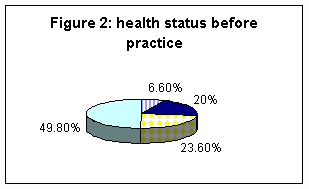
3 diseases - 49.8%, 2 diseases – 23.6%, 1 disease – 20.0%, healthy – 6.6%
Table 3: health status after practice
| Recovery | Fully | Basically | Partly | None | Total | Total effective |
| Number | 6,962 | 2,959 | 1,876 | 107 | 11,892 | 11,785 |
| % | 58.5% | 24.9% | 15.7% | 0.9% | 100% | 99.1% |
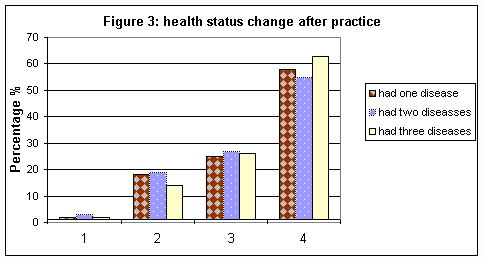
1 - No change, 2 - Some recovery, 3 - Almost recovered, 4 - Completely recovered.
3.5 Medical expenses saved: The survey population saved 41,700,000 Yuan (~$5,140,000) and an average of 3,270 Yuan (~$654) per person per year.
3.6 Comparison of physical health: Table 4 shows the physical health status before and after practice. 9,871 (80.3%) practitioners had improvement in their physical conditions; among them, "very energetic" people increased from 3.5% to 55.3%. Figure 4 compared the percentage of distribution of health status.
Table 4: Physical health status before and after practice
| Hard to work | Can work | Normal working | Energetic | Total | |
| Number before practice | 1,788 | 5,799 | 4,700 | 444 | 12,731 |
| % | 14.4% | 45.5% | 36.6% | 3.5% | 100% |
| Number after practice | 171 | 1,442 | 4,085 | 7,033 | 12,731 |
| % | 1.3% | 11.3% | 32.1% | 55.3% | 100% |
1 = Hard to work 2. Can work 3. Work normally 4.Energetic
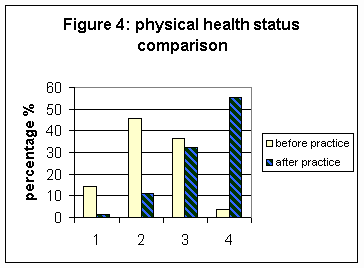
3.7 Comparison of mental health: Table 5 shows that before practice, 52.4% people bore heavy or mild mental stress. After practice, 12,287 practitioners (96.5%) had improvement in their mental health; among them, 7,202 (56.6%) achieved "Happy"; 3,447 (27.0%) had "Significant improvement"; 1,638 (12.8%) had "Some improvement" (Table 6).
Table 5: Mental health status before cultivation
| Very stressful | stressful | normal | happy | total | |
| number | 3,075 | 3,598 | 5,311 | 747 | 12,731 |
| % | 24.1% | 28.3% | 41.7% | 5.9% | 100% |
Table 6: Mental health status after cultivation
| No change | changed | Big change | happy | total | |
| number | 444 | 1,638 | 3,447 | 7,202 | 12,731 |
| % | 3.6% | 12.8% | 27.0% | 56.6% | 100% |
3.8 Comparison of health status change among the disease free population: 839 practitioners (6.6%) had no disease before starting practice. The change of their physical and mental health conditions is as follows: physical health: 486 or 57.9% among the 839 practitioners had improvement; mental health: 742 or 88.4% among the 839 practitioners had improvement (see Table 7, 8).
Table 7: Healthy people’s mental health status before cultivation
| Very stressful | stressful | normal | happy | total | |
| number | 72 | 87 | 523 | 157 | 839 |
| % | 8.5% | 9.5% | 62.3% | 19.7% | 100% |
Table 8: Healthy people’s mental health status after cultivation
| No change | changed | Big change | happy | total | |
| number | 97 | 126 | 167 | 449 | 839 |
| % | 11.6% | 15.0% | 19.9% | 53.5% | 100% |
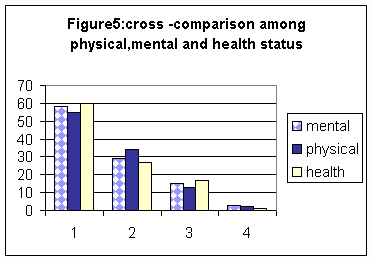
3.9 Physical and mental health correlation analysis: Figure 5 shows cross comparison of the relationship among physical, spiritual, and health conditions change after cultivation. Table 9 shows the data group. From Figure 5, one can see the disease healing, physical improvement, and mental health are related.
Table 9. Correlation among mental aspect, physical aspect, and health in general (by
group)
| Group 1 | Group 2 | Group 3 | Group 4 | |
| Mental | Happy | Big improvement | Improved | No change |
| Physical | Energetic | Normal | Can work | Hard to word |
| Health | Fully recovered | Recovered | Improved | No change |
4. Discussion
(1) Healing diseases, strengthening body and raising people’s health standard
According to the survey, out of 12,731 participants, 93.4% had ill conditions, and 49.8% had suffered from at least three diseases before they began practicing Falun Dafa. Through learning and practicing Falun Dafa, practitioners’ health conditions have improved in various degrees. The total effective cases reached 99.1%, among which complete recovery rate was 58.5%. Comparing the changes of body conditions before and after Falun Dafa practice, 80.3% of the participants improved their health. Among these people, the fraction of "very energetic" increased to 55.3% after practice from 3.5% before practice. The facts demonstrate that Falun Dafa is remarkably effective in curing diseases and improving health conditions. According to modern medical science, being healthy includes two aspects: a healthy body and a healthy mind. The survey shows that 12,287 people became psychologically healthier after practicing Falun Dafa, this accounts 96.5% of the total participants in the survey.
With the development of the society, people’s living standard has been rising, and people’s need for physical betterment has been getting higher and higher, and our country has been advocating the movement of health improvement of the entire population. The survey indicates that the number of people practicing Falun Dafa keeps increasing every year, and that the growth is becoming more and more rapid, and the trend is almost linearly going up. The fact that Falun Dafa has such a great number of practitioners, and is acknowledged and accepted by the general public, clearly proves that Falun Dafa indeed is effective in healing illnesses and improving physical conditions.
(2) Saving medical expenditure and medical resources
According to the survey, Falun Dafa practitioners can save 3,270 Yuan of medical expenses per person per year for the state. Falun Dafa practice has saved tremendous amount of medical cost and medical resources and has relieved the burden of the society and Chinese families. The positive effects are apparent. This important fact shows that Falun Dafa is beneficial for both people and the state.
(3) The important factor for healing illnesses – the improvement of a
practitioner’s mental state
The survey shows that 83.6% of the Falun Dafa practitioners’ mental conditions had
remarkable improvement. Through parallel analysis of people’s physical and mental
conditions, it was demonstrated that there was a close correlation between recuperated,
strengthened physical body and the person’s mental state. The theory of modern
medical science suggests that disease is caused by social factors, environmental factors
and biological factors, and that the three aspects affect human body in a large degree
through the mental effect, and thus lead to illnesses and unhealthy conditions. Therefore,
the mental state plays a crucial role in man’s health. One of the outstanding
characteristics of Falun Dafa is the requirement for practitioners to put raising their
mental realms to the first place in their cultivation practice. By improving a
person’s mental conditions through elevating his (her) morality and virtues, Falun
Dafa brings one’s physical body to the desired healthy state. Obviously, cultivating
heart and practicing exercises have great effects on the improvement of
practitioners’ physical and mental health.
By practicing Falun Dafa, practitioners generally established positive attitude in daily life, elevated personal morality and virtues, improved one’s relationship with others, and became more sensible of public responsibilities. All this accelerates the society’s spiritual civilization. The advancement of mankind’s spiritual civilization will definitely generate a better and more stable social environment, create more beautiful hearts, and make people’s mind and body truly healthy. The sublimation of people’s mind and nature will certainly bring the prosperity of the entire mankind.
The survey’s statistical study shows another fact that is worth to be emphasized.
A large portion of Falun Dafa practitioners were perfectly healthy before Falun Dafa
cultivation and their motivation for the practice totally comes from their love towards
Chinese traditional culture. They were attracted by the profound principles of Falun Dafa.
Participating researchers:
| Name | Hospital / Institution | Title |
| Lin Dan | China Union Medical University, Basic Science College |
Assistant Prof. |
| RiYang Pu | China Union Medical University Hospital | Post Doctor |
| FuJun Li | China Union Medical University Hospital | Post Doc., Assistant Prof. |
| NaiYuan Li | Beijing Medical University, (Oral-Maxillary Hospital) | Attending Physician |
| Qi Wang | The Chinese People's Police General Hospital | Attending Physician |
| Ying Lu | Beijing Hospital No.2 | Attending Physician |
| CaiXi Li | Chinese Traditional Medicine Research Institute, Xiyun Hospital |
Researcher |
| ZhiYun Liu | Chinese Traditional Medicine Research Institute, Xiyun Hospital | Associate Researcher |
| ShuQing Feng | The Chinese People's Military General Hospital 304 | Assistant Physician |
| ChengTao Lin | China Union Medical University, Basic Science College | Assistant Researcher |
| Xiao Liu | China Union Medical University, Basic Science College | Practical Researcher |
October 23, 1998
Appendix
Questionnaire for Health Improvement Survey of Falun Dafa Practice
Number |
Name |
Gender (M/F) |
Age |
Length of Practice |
Practice Location |
1. Health condition before practice: [ ]
2. Health condition after practice: [ ]
3. Body condition before practice: [ ]
4. Body condition after practice: [ ]
5. Mental condition before practice: [ ]
6. Mental condition after practice: [ ]